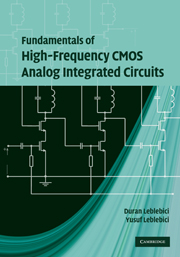Book contents
- Frontmatter
- Contents
- Preface
- 1 Components of analog CMOS ICs
- 2 Basic MOS amplifiers: DC and low-frequency behavior
- 3 High-frequency behavior of basic amplifiers
- 4 Frequency-selective RF circuits
- 5 L-C oscillators
- 6 Analog–digital interface and system-level design considerations
- Appendix A Mobility degradation due to the transversal field
- Appendix B Characteristic curves and parameters of AMS 0.35 micron NMOS and PMOS transistors
- Appendix C BSIM3-v3 parameters of AMS 0.35 micron NMOS and PMOS transistors
- Appendix D Current sources and current mirrors
- References
- Index
2 - Basic MOS amplifiers: DC and low-frequency behavior
Published online by Cambridge University Press: 05 June 2012
- Frontmatter
- Contents
- Preface
- 1 Components of analog CMOS ICs
- 2 Basic MOS amplifiers: DC and low-frequency behavior
- 3 High-frequency behavior of basic amplifiers
- 4 Frequency-selective RF circuits
- 5 L-C oscillators
- 6 Analog–digital interface and system-level design considerations
- Appendix A Mobility degradation due to the transversal field
- Appendix B Characteristic curves and parameters of AMS 0.35 micron NMOS and PMOS transistors
- Appendix C BSIM3-v3 parameters of AMS 0.35 micron NMOS and PMOS transistors
- Appendix D Current sources and current mirrors
- References
- Index
Summary
Basic MOS amplifiers are the main building blocks of a vast array of analog signal processing systems as well as other analog electronic circuits. The overall performance of a complex circuit strongly depends on the performances of its basic building blocks. In this chapter the main properties of these basic circuits will be investigated.
Common source (grounded source) amplifier
The basic structure of a common source amplifier is shown in Fig. 2.1(a). The gate of the NMOS transistor, M, is biased with a DC voltage source VGS, to conduct the appropriate DC (quiescent) current. A signal source (vi) is connected in series with the bias voltage to control the drain current. The load resistor RD helps to convert the drain current variations into output voltage variations (output signal). Since the output of a MOS amplifier is usually connected to the gate of another MOS amplifier, the DC and low-frequency load coming from the subsequent stage is negligible and the only load is RD. In Fig. 2.1(b), this “DC load line” with a slope equal to (−1/RD) is drawn on the output curves of M. For a given value of the gate bias voltage (for example VGS1), the drain current is ID1, which corresponds to the intersection of the load line and the output curve corresponding to VGS1. This intersection point is called as the “operating point” or the “quiescent point” and denoted by Q.
- Type
- Chapter
- Information
- Publisher: Cambridge University PressPrint publication year: 2009



